2008 VOLKSWAGEN BEETLE warning
[x] Cancel search: warningPage 28 of 138
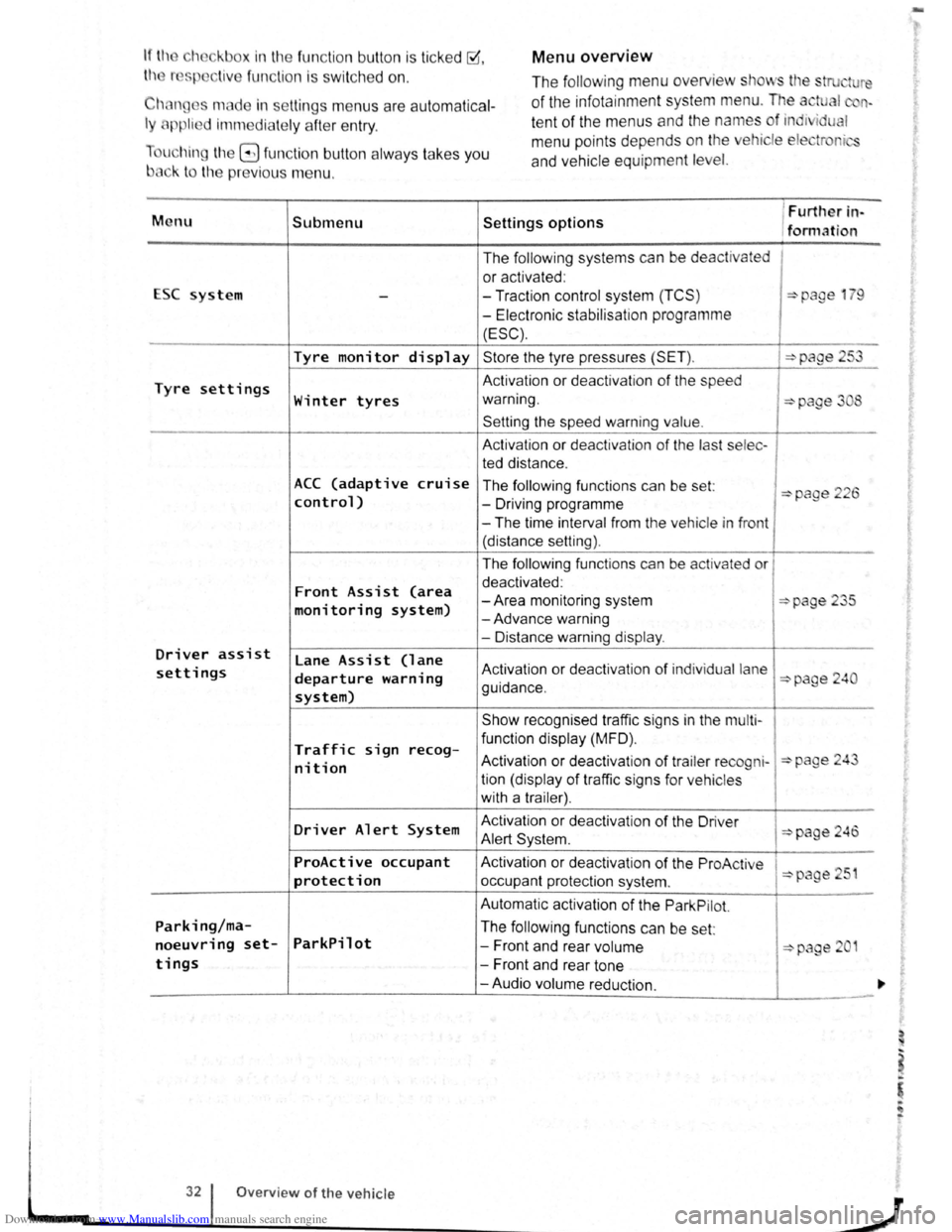
Downloaded from www.Manualslib.com manuals search engine Menu overview If the eh ckbox in the fun ction button is ticked ~.
th r sp liv e fun ction i s swi tc h ed on .
Chan ges made in settin gs menu s are autom atica l
ly applie d imm ediate ly afte r entry .
u hin g
t11e G fun ction button alw ays ta kes you
b3ck to the previo us m enu . The
following menu overview
stows tl e stru ture
of the infota inment system menu. The a tual n
te nt of the menus and the names of ind1 i u I
m enu points depends on the ehicle ele tr r i
and ve hicle equ ipment level.
M enu Submenu Settings options
1 Furtller in-
/formation
The
follow ing systems can be de activated
or activated :
ESC system
--Traction control system (TCS ) :::>page 1 9
-Electronic stabilisat ion programme
(ESC).
Tyre monitor display Store the tyre pressures (SET ). :::>page 253
Tyre settings Activation or deactivat ion of the speed
Winter tyres warning. :::>page 3 8
Setting the speed warning value.
A ctivation or dea ctivation of the last selec -
ted distance .
ACC (adaptive cruise The following functions can be set: :::>page 226 control) -Driving programme
-The time interval from the vehicle in front
(distance setting).
The
follow ing functions can be activated or
Front Assist (area deactivated :
-Area monitoring system :::>page 235 monitoring system) -Advance warning
- Distance warning
display .
Driver assist lane Assist (lane settings departure warning Activation or deactivation of ind iv idual lane :::>page 240
system) guidance .
Show recognised traffic signs in the
mu lt i-
Traffic sign func tion display (MFD) . recog-Activation or deactiv atio n of trailer re cogni-:::>page 24 nit ion tion (display of traffic signs for ve hicles
with a trailer) .
Driver Alert System Activation
or deactivation of the Driver :::>page 246 Alert Syst em .
ProActive occupant Activation or dea ctiv atio n of the ProAc tive 51 protection occupant protection system . :::>page
Automatic activation of the Park Pilot.
Parking/ma-The following functions can be set:
noeuvring set-ParkPilot -Front and rear volume :::::>page 2 1
tings -Front and rear tone
-Audio volume reduction.
32 Overview of the vehicle
J
-
Page 30 of 138
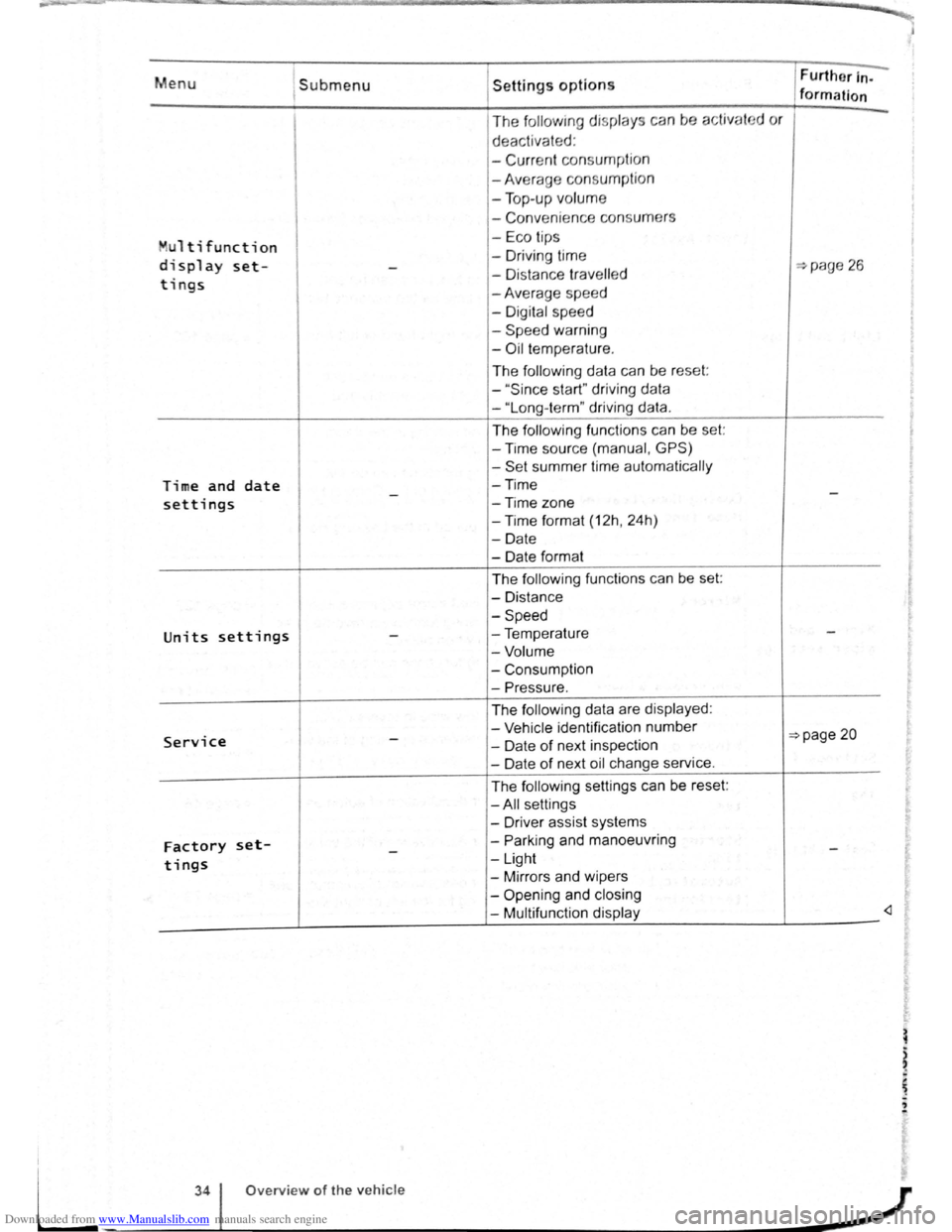
Downloaded from www.Manualslib.com manuals search engine Menu 1submenu
Multi function
display set--
tings
Time and date -settings
Units settings -
Service -
Factory set--tings
Settings options
The following display s ca n be activat
deactivated :
-
Curr ent consu mption
-Average consumpti on
- Top -up volume
- Conveni ence consum ers
- Eco tips
- Driv ing time
- Di stance
travell ed
-Average spee d
- Digital speed
-
Speed warning
-Oil t empe rature .
The
foll ow ing data can be reset:
-
" Sin ce start" driving data
-"Long -term" driving data.
The following functions can be set:
-Time source (manual , GPS)
-Set summer time automatically
-Time
-Time
zone
-Time format (12h, 24h)
-Date
- Date format
The
following functions can be set:
-Distance
-Speed
-Temperature
-Volume
-Consumption
-Pressure.
The follow ing data are displayed :
- Vehicle identification number
- Date
of next inspection
-Date of next oil change service.
The
following settings can be reset:
-All settings
- Driver assist systems
-
Parking and manoeuvring
-Light
-Mirrors and wipers
-
Opening and closing
- Multifunction display Further
In-
formation ~ ~
d
or
...,page 26
-
-
=>page 20
-
-
"'
L
34 Overview of the vehicle
-~~------------~J
Page 31 of 138
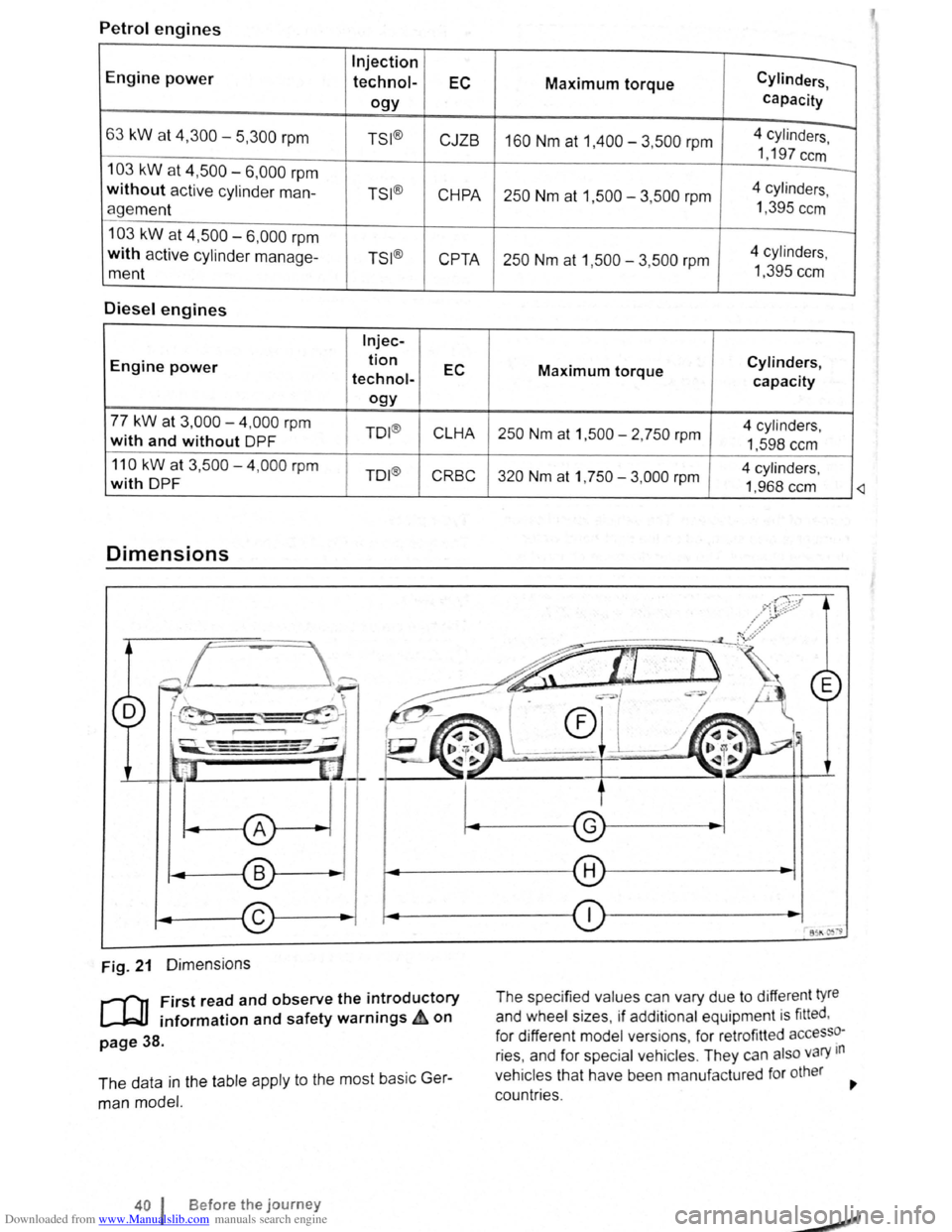
Downloaded from www.Manualslib.com manuals search engine Petrol engines
Engine power
Injection
technol-EC
ogy
63 kW at 4,300-5,300 rpm TSI ®
CJZB
103 kW at 4,500 6,000 rpm
without active cylinder man-TSI®
CHPA
agement
103 kW at 4,500 6,000 rpm
with active cylinder manage-TSI®
CPTA
ment
Diesel engines
lnjec-
Engine power tion
EC technol-
ogy
77 kW at 3,000-4,000 rpm TO I®
CLHA with and without DPF
110
kW at 3,500-4 ,000 rpm TO I®
CRBC with DPF
Dimensions
Fig. 21 Dimensions
r-f"n First read and observe the introductory
L.-Jr=JJ information and safety warnings ~ on
page 38.
The data in the table apply to the most basic Ger
man model.
40 I Before the journey
Maximum torque Cylinders
capacity
,
4 cylinders -160 Nm at 1,400 -3,500 rpm I
1,197 ccm
-
250 Nm at 1,500-3,500 rpm 4
cylinders ,
1 ,395
ccm
250 Nm at 1,500 -3 ,500 rpm 4
cylinders ,
1 ,395 ccm
Cylinders, Maximum torque
capacity
250 Nm at 1 ,500 - 2, 750 rpm 4 cylinders ,
1,598 ccm
320 Nm at 1, 750 -3,000 rpm 4
cylinders ,
1 ,968 ccm
The specified values can vary due to diffe rent t
yre
and wheel sizes , if add itional equipment is fitted ,
for different model versions , for retrofitted
accesso
ries , and for special veh icles . They can also vary 1n
vehicles
that have been manufa ctured for other
countr ies.
£
Page 32 of 138
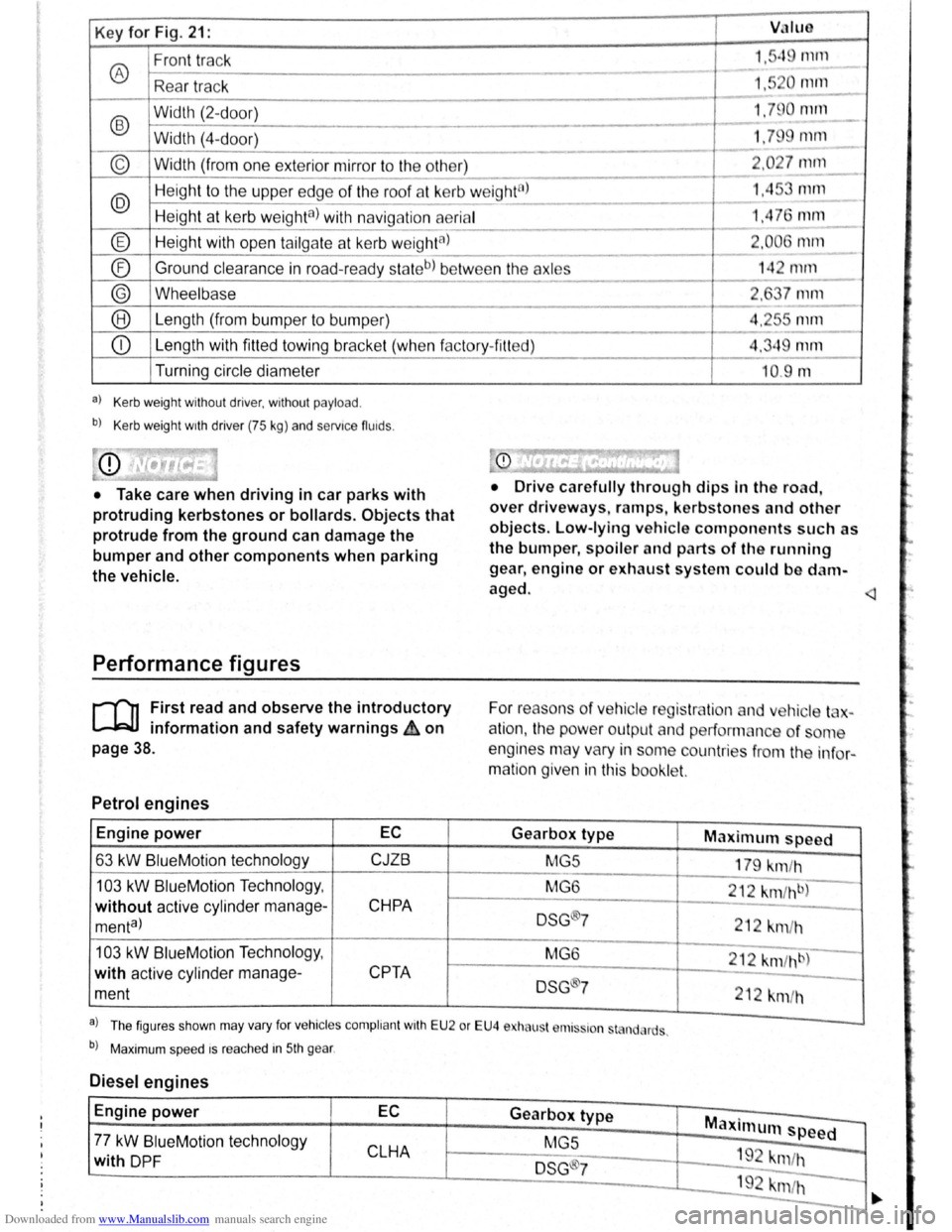
Downloaded from www.Manualslib.com manuals search engine Key for Fig. 21: VJIUO
Front track 1."q rnrn
® ---
Rea r tr ac k 1,5 0 111112.._
-
®
Width (2-d oor) 1.79 0 null
- -Width (4-
door) 1.79 mm
----
© Width (from one exterior mirror to the other) 2 .0 27 mm
---
@ Heig ht to the uppe r edge of the roof at kerb w eight8l 1.45 mm ---
Height at kerb weighta) with navig ation aerial 1,4 76 mm ---
® Height with open tailga te a t kerb w eightal 2.006 1111ll
- --
® Ground
clearance in road-read y sta teb) be tw ee n the axles 14 2 mrn ------
® Wheelbase 2, 7 mm
--® Le ngth (from bumper to bump er) 4.2r-s mm
---
CD Length with fitted towing bracke t (whe n f actory- fitt ed) 4.349 mm
Turning circle diameter
a) Kerb weight without driver, without payload .
b) Kerb weight wrth driver (75 kg) and servrce fluids .
• Take care when driving in car parks with
protruding kerbstones or bollards. Objects that
protrude from the ground can damage the
bumper and other components when parking
the vehicle.
Performance figures
r-('n First read and observe the introductory
L-1=JJ information and safety warnings ih on
page 38.
Petrol engines
Engine power EC
63 kW BlueM otio n technology CJZB
103 kW BlueMotion Techno logy ,
without active cylind er manage-CHPA
menta)
103 kW Blue Motio n Technolog y,
with active cylinder manage-
CPTA
ment
--10.9 m
• Drive c arefully through dips In the road,
over driveways, ramps , kerbstones and other
objects. Low-lying vehicle components such as
the bumper, spoiler and parts of th e running
gear , engine or exhaust system could be d am
aged.
For reaso ns
of ve hicle reg is tr lio n and v hic le t -
a
tio n, the pow er outpu t an d performan ce of ome
engines may vary in some countries f
rom the in fo r
matio n given in this booklet.
Gearbox type Maximum speed
MG5
179 km/h
MG 6
212
km fh b)
DSG ®7 212 km /h
M G6
212 km /hb)
DSG 7
212 km/h
a . . l Th e figur es sh o wn may va ry fo r vehrc les compli ant wrth E U 2 or EU4 e ha ust r111s~ron st nd, rds .
b) Maxim um spee d rs rea ched in 5th gear .
Diesel engines
Engine power EC Gearbox type Maxi mum speed -77 kW BlueM otio n tec hnol ogy
MGS
CLHA 1 9 -with DP F DSG ®7 "m /h
192 krn/h -
-
·.
Page 33 of 138
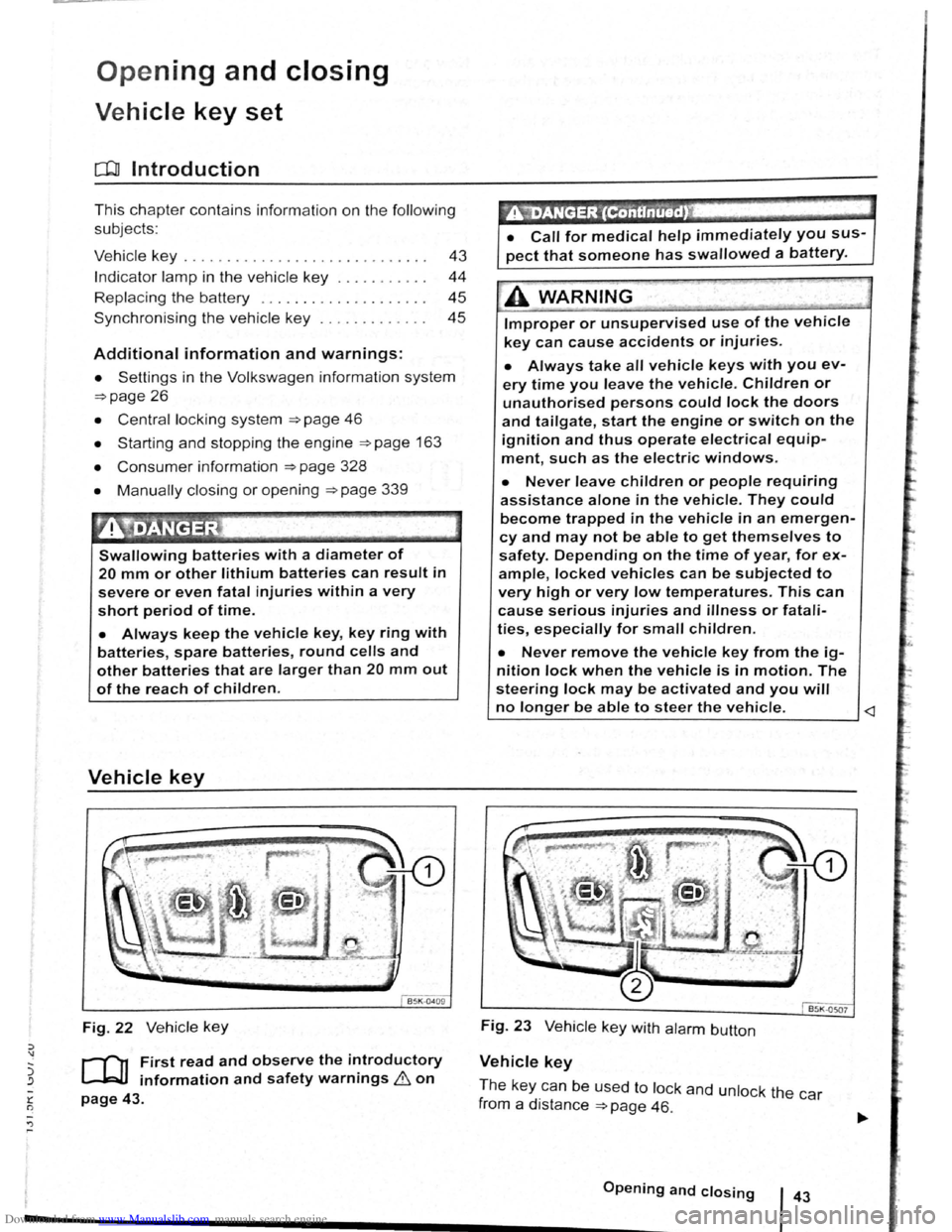
Downloaded from www.Manualslib.com manuals search engine -r n -"') ...
Ope ning and closing
Vehi cle key set
ClJJ Introduction
Th is c hapte r contai ns info rmatio n on th e fo llo wi ng
subj ects:
V eh
icle ke y . . . . . . . . . . . . . . . . . . . . . . . . . . . . . 43
I
ndicator l amp in th e ve hi cle key . . . . . . . . . . . 44
Replacing the battery . . . . . . . . . . . . . . . . . . . . 45
S yn ch ronis ing the ve hicle key . . . . . . . . . . . . . 45
Additional information and warnings:
• Settin g s in the Volkswagen inform atio n system
=>page 26
• Central locking sys te m =>page 46
• S tarti ng and stopping the engine =>page 163
• Consumer info rmation =>page 328
• Manua lly closin g or open ing =>page 339
Swallowing batteries with a diameter of
20 mm or other lithium batteries can result in
severe or even fatal injuries within a very
short period of time.
• Always keep the vehicle key, key ring w ith
batteries, spare batteries, round cells and
other batteries that are larger than 20 mm out
of the reach of children.
Vehicle key
Fig. 22 Ve hicle key
r-('n First read and observe the introductory
L-J.=J.I information and safety warnings & on
page 43.
~"iDANGER '(ContinUed) .
• Call for medical help immediately you sus
pect that someone has swallowed a battery.
A WARNING . .,~
Improper or unsupervised use of the vehicle
key can cause accidents or injuries.
• Always take all vehicle keys with you ev
ery time you leave the vehicle. Children or
unauthorised persons could lock the doors
and tailgate, start the engine or switch on the
ignition and thus operate electrical equip
ment, such as the electric windows.
• Never leave children or people requiring
assistance alone in the vehicle. They could
become trapped in the vehicle in an emergen
cy and may not be able to get themselves to
safety. Depending on the time of year, for ex
ample, locked vehicles can be subjected to
very high or very low temperatures. This can
cause serious injuries and illness or fatali
ties, especially for small children.
• Never remove the vehicle key from the ig
nition Jock when the vehicle is in motion. The
steering Jock may be activated and you will
no longer be able to steer the vehicle.
Vehicle key
Th e ke y ca n b e used t o lock and unlock th e car
f rom a
distance =>page 46.
------------------.............................................. O•p•e•n•i•n•g•a•n•d--c-lo_s_i_n_g ___ l 43
Page 34 of 138

Downloaded from www.Manualslib.com manuals search engine The remote control transmitte r and the battery are
integrated in the key. Th e receiver is located
in the
vehicl e int erio r. The remote control range is several
metres around the vehicle when the battery is
fully
charged.
If the vehicle cannot be opened and closed using
the vehicle key, the vehi cle key
will have to be re
synchro
nise d ~page 45 , or the battery in the key
r ep laced
~page 45 .
Several vehicle keys can be used .
Opening and closing the key bit
Press button ~Fig. 22 G) or ~Fig. 23 G) to re
lease the key bit and
fold it out.
To fold in, press button G) and simultaneously fold
in the key bit until it clicks into place .
Alarm button
Only press the alarm button 0 in the event of an
emergency .
Once the button is pressed , the horn is
sounded and the vehicle lights flash.
Press the
alarm button again to switch off the alarm.
Replacement key
You will need to quote the vehicle chassis number
when ordering a replacement key or additional re
mote control keys.
Every new key contains a microchip which must be
encoded with the data for the
vehicle 's electronic
immobilizer . The vehicle key will not work if it is not
fitted with a micro chip, or if the microchip has not
been encoded. The same goes for keys that have
been cut to fit the
vehicle .
New keys or replacement keys are available from
Volkswagen dealerships or from qualifi
ed work
shops and authorised key services that are quali
fied to manufacture these
vehicle keys.
Indicator lamp in the vehicle key
B5K 0602
Fig. 24 Indicator lamp in the vehicle key
44 Before the journey
New and replace ment veh icle keys must be
sync hron ise d before use.
Proce ed to a qu alified
work sho p.
nents. Protect the key from damage, moisture
and excessive vibration.
m Press the buttons on the ke y only if the corre
L!J spending function is actually needed. Press
ing a button when the functio n is not required could
lead to the vehicle be ing unlocked unintentionally
or the alarm going off. Thi s also applies even when
you are not wi
thin the effective range.
m The functio n of the vehicle ke y can be affec
W ted temporarily if there is more than one
transmitte r in the direct vicinity working on the
same frequency (e.g . a two -way radio
or mobile
telephone).
m Obstacles between the ke y and the vehicle ,
W bad weather conditions and weak batteries
can reduce the range
of the remote control.
m If the buttons ~Fig. 22 or ~Fig. 23 on the
W vehicle key or one of the central lock ing but
tons
~page 46 are pressed repeated ly within a
short period
of time, the central locking system will
switch off briefly to prevent overloading . The vehi
cle
will then be unlo cked . Lo ck the vehicle if neces -
sary .
mformat1on and safety warnings 8 on
page 43.
!f a_ button on the vehicle key is pressed briefly, the
1nd1cator lamp ~Fig. 24 (arrow) flashes once. The
lamp will flash several times if the button is press
ed and held, e .
g. convenience opening.
If the indicator lamp in the key does not light up
when a button is pressed , the battery
in the key
should be replaced
~page 45. ,... a: "? ,... M ,...
Page 35 of 138
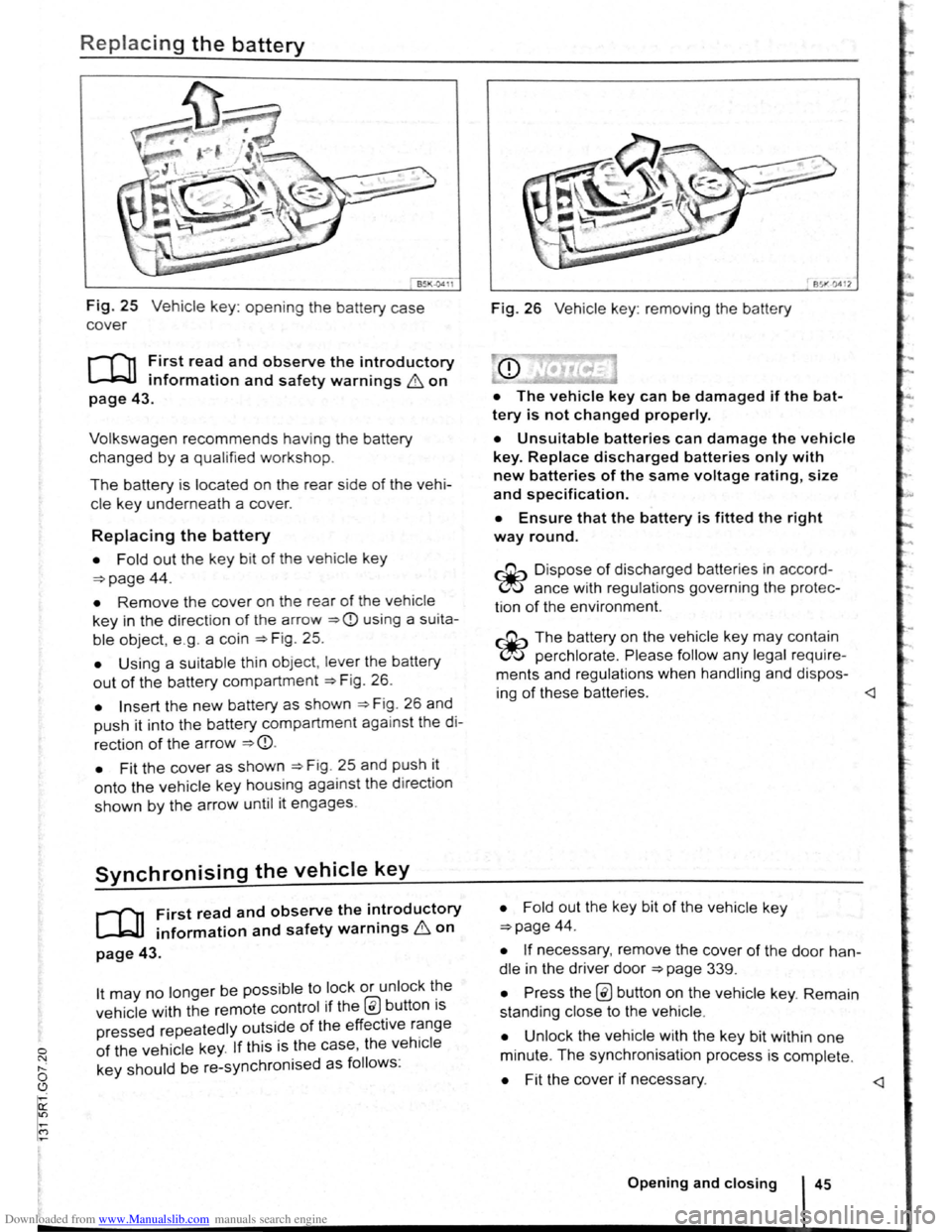
Downloaded from www.Manualslib.com manuals search engine 0 N t--o ~
Replacing the battery
Fig. 25 Vehicle key: opening the battery case
cover
r-f""n First read and observe the introductory
L-kJJ information and safety warnings & on
page 43.
Volkswagen recommends having the battery
changed by a qualified workshop.
The battery is located on the rear side of the vehi
cle ke y underneath a cover.
Replacing the battery
• Fold out the key bit of the vehicle key
=>page 44.
• Remove the cover on the rear of the vehicle
key in the direction of t h e a rrow =>CD using a su ita
ble object, e .g . a coin =>Fig . 25.
• Using a suitable th in object, lever the battery
out of the battery compartment =>F ig . 26.
• Insert the new battery as shown =>F ig . 26 and
push it into the battery compartment against the di
rection of the arrow =>CD.
•
Fit the cover as shown =>F ig . 25 and push it
onto the vehicle key housing against the d irect ion
shown by the arrow until it engages.
Synchronising the vehicle key
r-f11 First read and observe the i~troductory
~ information and safety warnmgs 6 on
page 43.
lt may no longer be possible to lock or unlock t~e
vehicle with the remote control if the @ button ts
pressed repeatedly outside of the effective r~nge
of the vehicle key. If this is the case, the vehtcle
key should be re-synchronised as follows:
851"·0412
Fig. 26 Vehicle key: removing the battery
• The vehicle key can be damaged if the bat
tery is not changed properly.
• Unsuitable batteries can damage the vehicle
key. Replace discharged batteries only with
new batteries of the same voltage rating, size
and specif ication.
• Ensure that the battery is fitted the right
way round.
~ Dispo se of discharged batteries in accord
~ ance with regulations governing the protec
tion
of the enviro nment.
~ The battery on the vehicle key may contain
~ perchlorate . Please follow any legal require
ments and regulations when handling and dispos-
ing
of these batteries.
=>page 44.
• If necessary, remove the cover of the door han
dle in the driver door =>page 339.
• Press the @ button on the vehicle key. Remain
standing close to the vehicle .
• Unlock the vehicle w ith the key bit within one
minute. The synchronisation process is complete.
• Fit the cover if necessary.
Page 36 of 138
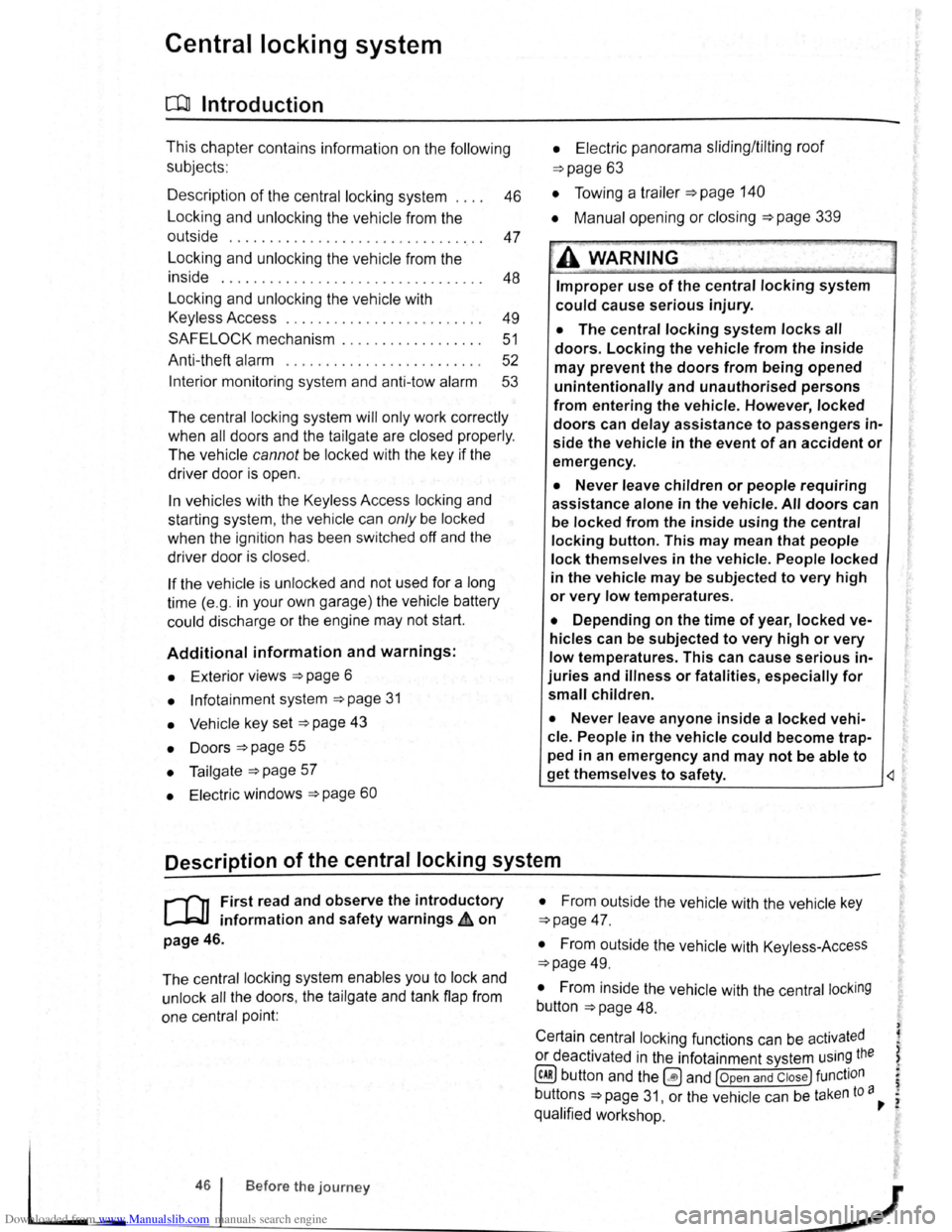
Downloaded from www.Manualslib.com manuals search engine Central locking system
c:DJ Introduction
This chapter contains information on the following
subjects:
Description
of the central locking system 46
Locking and unlocking the vehicle from the
outside . . . . . . . . . . . . . . . . . . . . . . . . . . . . . . . .
47
Locking and unlocking the vehicle from the
inside . . . . . . . . . . . . . . . . . . . . . . . . . . . . . . . . .
48
Locking and unlocking the vehicle with
Keyless Access . . . . . . . . . . . . . . . . . . . . . . . . . 49
SAFELOCK mechanism . . . . . . . . . . . . . . . . . . 51
Anti-theft alarm . . . . . . . . . . . . . . . . . . . . . . . . . 52
Interior monitoring system and anti-tow alarm 53
The central locking system
will only work correctly
when all doors and the tailgate are closed properly.
The
vehicle cannot be locked with the key if the
driver door is open .
In vehicles with the Keyless Access locking and
starting system, the
veh icle can only be locked
when the ignition has been switched
off and the
driver door is closed .
If the vehicle is unlocked and not used for a long
time (e.g. in your own garage) the
vehicle battery
could discharge
or the engine may not start.
Additional information and warnings:
• Exterior views ~page 6
• lnfotainment system ~page 31
• Vehicle key set ~page 43
• Doors ~page 55
• Tailgate ~page 57
• Electric windows ~page 60 •
Electric
panorama sliding/tilting roof
~page 63
• Towing a trailer ~page 140
•
Manual opening or closing ~page 339
A WARNING
Improper use of the central locking system
could cause serious injury.
• The central locking system locks all
doors. Locking the vehicle from the inside
may prevent the doors from being opened
unintentionally and unauthorised persons
from entering the vehicle . However, locked
doors can delay assistance to passengers in
side the vehicle in the event of an accident or
emergency.
• Never leave children or people requiring
assistance alone in the vehicle. All doors can
be
locked from the inside using the central
locking button. This may mean that people
lock themselves in the vehicle. People locked
in the vehicle may be subjected to very high
or very low temperatures.
• Depending on the time of year, locked ve
hicles can be subjected to very high or very
low temperatures. This can cause serious in
juries and illness or fatalities, especially for
small children.
• Never leave anyone inside a locked vehi
cle. People in the vehicle could become trap
ped in an emergency and may not be able to
get themselves to safety.
Description of the central locking system
r-('n First read and observe the introductory
L-Jr=JJ information and safety warnings & on
page 46.
The central locking system enables you to lock and
unlock
all the doors, the tailgate and tank flap from
one central point:
• From outside the vehi cle with the vehicle key
~page 47.
• From outside the vehicle with Keyless-Access
~page 49.
• From inside the vehicle with the central locking
button ~page 48.
Certain central locking functions can be activated
or deactivated in the infotainm ent system using the
@ill button and the~ and (Open and Clos e) function
buttons =>page 31, or the vehicle can be taken to a~
qualifi ed work shop .
--~--------------------~~